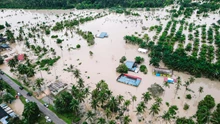
Through prototype technology and farming practices, the ADAPT-Wheat programme will assist small and medium-sized wheat farmers in Ethiopia's Awash Valley. The Adaptation, Demonstration, and Piloting of Wheat Technologies for Ethiopia's Irrigated Lowlands (ADAPT-Wheat) initiative began in October of last year, in Adama, Ethiopia, with an inception workshop.
The International Maize and Wheat Improvement Center (CIMMYT) is leading a project to convert Ethiopia's Awash valley's irrigated lowlands from cotton monoculture to cotton-wheat rotation. This change will boost local wheat production and contribute significantly to the country's objective of wheat self-sufficiency.
Wheat is Ethiopia's second most important staple crop and a key component of food security. CIMMYT has long aided Ethiopian wheat producers in the adoption of superior, high-yielding, disease-resistant cultivars. In 2018, DNA fingerprinting studies revealed that CIMMYT-derived wheat varieties account for 87 percent of all wheat types produced in Ethiopia.
Domestic wheat output and productivity in Ethiopia have virtually doubled in the last 15 years thanks to enhanced farmer access to superior varieties, the implementation of a variety of agronomic management recommendations, favourable marketing, and strong supply networks. Despite this, demand for wheat in Ethiopia is growing faster than productivity due to population increase, higher incomes, and accelerated urbanization.
Scientists believe that if wheat production is increased through appropriate mechanization, proven agronomic practices, and high-yielding, early-maturing, heat-tolerant, rust-resistant wheat varieties, wheat grain yields of four tonnes per hectare can be achieved in low-land areas such as the Afar and Oromia regions. Ethiopia's goal of wheat self-sufficiency by 2023 will be achieved when the three-year ADAPT-Wheat project is fully executed.
Space for Discussion
Participants gathered during the launch event to share their thoughts and experiences, identify gaps, and define roles and duties among the implementing partners. Project leaders were also able to confirm participating kebeles (small administrative units) and organize and approve project activities during the conference.
"The forum provided a fantastic opportunity to talk about irrigated wheat, get to know each other, and understand the function of each office and its contribution to the project's success," said Bekele Abeyo, CIMMYT's Ethiopian Country Representative. Scientists from a number of Ethiopian research institutes, representatives from public and private seed enterprises, heads of agriculture bureaus (including those in the Afar and Oromia regions), local administrations, and representatives from Germany's Agency for International Cooperation were among those who attended the workshop (GIZ).
The essential agronomy, breeding, and mechanization operations that will be assessed validated, scaled up, and scaled out during the project in seven districts, two in the Afar area and five in the Oromia region, were also discussed.
The inception and planning workshop have reached a consensus on how to address bottlenecks prior to the project's deployment. "The meeting provided an excellent opportunity for implementing partners to commit to the new project by recognising the importance of lowland irrigated wheat in achieving wheat self-sufficiency by 2023," Bekele said.










